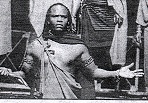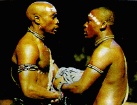Shakespeare in South Africa: Sezar Reviews (British)
Shakespeare in South Africa: Yael Farber's SeZar -- page 5
SeZar: newspaper reviews (British)
Click on the links to see scanned newspaper articles.
| 1. Richard Hollingum in The Oxford Times Weekend , 28 September 2001.
Click on the "back" button of your browser to return to this page. |
 |
| 2. Karen Basson - source unknown.
Click on the "back" button of your browser to return to this page. |
 |
3. Sharae Deckard in the Oxford Daily Information, 25 September 2001 (text follows).
This stunning production comes from the stages of South Africa. Writer and Director Yael Farber has powerfully adapted Shakespeare's Julius Caesar, setting the play in the context of a fictionalized African nation state, Azania, and mingling Elizabethan verse with the pungent rhythms of South African dance, poetry and dialects. The play is suspended between myth and modernity: radio broadcasts take the place of a chorus, punctuating the action with accounts of street riots, AIDS, violence and upheaval in neighbouring states; and the set is minimalistic, consisting mainly of two anonymous steel-girdered towers. The rituals that the characters perform are timeless, harking back to tradition and ancestors, and yet they are rooted in the reality of the present. SeZaR is an almost unearthly figure, whose charisma seems to emanate from a direct connection to the spirit world: he dances, shakes, trances under the power that posses him, his every action imbued with ritual. The signs and portents of Shakespeare's text are made wonderful and fearfully real, for this is a universe where ghosts walk and blood sacrifices are offered even as men struggle to build a modern nation: myth is history's mid-wife.
I have never seen a Julius Cesar so raw, so seething with the dynamics of power and betrayal. The Roman context can seem constrictive and bland, classical posturing and stoic endurance obscuring the real agony of democracy, all the violence of Shakespeare's text is uncovered: the audience is directly confronted with political turmoil and the violent modernity of modern African life. They are literally spattered with blood -- offal arching through the air as SeZaR swings aloft an offering of organs and flesh. Farber's multi-lingual text also sets up an encounter with the extraordinary heterogeneity of African culture: we must negotiate the different tongues and accents of the characters, and open our ears to the layers of poetry -- the melding of iambic pentameter with the complex rhythms of African song, drumming and speech. In Farber's play, language is invaded on every level by a new reality, and it is a testimony both to her skill as a writer and to the remarkable flexibility of Shakespeare's own text that this invasion is accomplished so perfectly, enabling new meaning to be dramatically born from an old play. Farber challenges our reality and our cultural solipsism, while providing a beautiful feast for eyes and ears.
I cannot recommend this highly enough: for its vibrancy, its intelligence and immediacy, its impeccable choreography -- the fight sequences were particularly exciting. There is nothing gimmicky about it. Brutas and Porshia delivered powerful, nuanced performances, balancing passion with nobility; Kassius was the perfect goad, driving the action with his unrelenting energy and his silver-tongued delivery. All of the small ensemble cast were uniformly strong, not just in acting but in singing and dancing as well. See it while you can.
previous page | Table of Contents| Shakespeare in S.A. | next page
